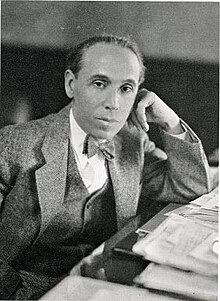Giuseppe Bellanca
Giuseppe Mario Bellanca (born March 19, 1886 in Sciacca , Italy , † December 26, 1960 in New York City ) was an Italian-American aircraft designer and builder .
Life
It is said that the 14-year-old Giuseppe Bellanca is said to have already dealt with aerodynamics by experimenting with a kite and improving its flight characteristics, so that his playmates turned to him to have their kites modified as well. His father is said to have recognized his son's talent and sent him to a local technology school. After attending this school, Giuseppe Bellanca switched to the Milan Polytechnic , where he completed a degree in engineering. He was already involved in the construction of aircraft during his studies. While studying a newspaper, he is said to have become aware of the flight of the French aviation pioneer Léon Delagrange , who on March 16, 1907 in Paris managed to stay in the air for six minutes in his Voisin biplane. This is said to have inspired Bellanca to design its own motor-powered airplane in 1909. However, the realization of this project failed because of the high cost of the engine.
In 1910 Bellanca moved to the USA, where he built his first airplane in Brooklyn, New York, in 1913, which he called the "Parasol". This construction with a pulling propeller driven by a 25 hp engine, the supporting structure in the middle and a tail unit at the rear differed greatly from the designs popular at the time, which, based on the example of the Wright brothers, mostly had a pusher propeller in the rear and the tail unit were equipped at the bow. Bellanca is said to have once said that after seeing the plane, experts said that he would survive a maximum of 15 days on the plane. However, these statements had shown him that these experts generally trusted the machine to lift off the ground. Ultimately, the “Parasol” had very good flight characteristics, and Bellanca learned to fly on the machine herself . In 1914 he founded the "Bellanca Flying School" in Mineola, Long Island, which was operated until 1916. A student was Fiorello H. LaGuardia , who in the First World War to ace became and later mayor of New York.
In 1921 Bellanca moved to Omaha, Nebraska, where he built his first high-wing aircraft called the CF. The CF was the first machine with the typical Bellanca struts, which, designed as aerodynamic elements, gave the wings stability on the one hand, but also generated additional lift. The machine was groundbreaking in 1922 and achieved thirteen first prizes in flight competitions. Against the cheap offers on the aircraft market - at that time machines could be bought for a few hundreds of dollars - the $ 5,000 machine had no chance. This machine is preserved and in the hands of the Smithsonian .
Since he could not achieve any financial income, Bellanca was penniless in 1924 and went to the eastern United States as a consultant to the Wright Aero Corporation in New Jersey and developed several single-engine monoplane, including the Wright-Bellanca WB-2 , a one-off as an engine mount with which various records were set. In the opinion of a number of aviation experts, this machine had the potential for the first non-stop Atlantic crossing, and Charles Lindbergh is said to have considered the WB-2 for this too and said that with this aircraft - contrary to the original plan - he could even cross the Atlantic without a navigator would cross. That he was not wrong with this view is shown by the fact that the WB-2 later not only flew further than Lindbergh's " Spirit of St. Louis " on its maiden flight over the Atlantic, but also took a passenger along with the pilot . Together with the purchaser of the WB-2, Charles Levine, Bellanca founded the Columbia Aircraft Corporation, and they named the WB-2 "Columbia". She was supposed to make the maiden flight across the Atlantic, but due to internal squabbles the take-off was delayed and Lindbergh got ahead of the company.
Bellanca later fell out with Levine and single-handedly re-founded an aircraft manufacturing company, the Bellanca Aircraft Corporation . In 1931 a machine named “Miss Veedol” made its first non-stop flight across the Pacific, and in the next five years Bellanca's machines flew one record after the next. The company continued to operate after the Second World War .
Bellanca left the company in 1954 and intended to build an airplane with his son August, but died of leukemia at Memorial Hospital in New York on December 26, 1960 at the age of 74 before the project was completed, leaving his wife Dorothy Brown behind Bellanca and his son August.
Web links
| personal data | |
|---|---|
| SURNAME | Bellanca, Giuseppe |
| ALTERNATIVE NAMES | Bellanca, Giuseppe Mario (full name) |
| BRIEF DESCRIPTION | Italian-American aircraft designer and builder |
| DATE OF BIRTH | March 19, 1886 |
| PLACE OF BIRTH | Sciacca (Italy) |
| DATE OF DEATH | December 26, 1960 |
| Place of death | New York City |
